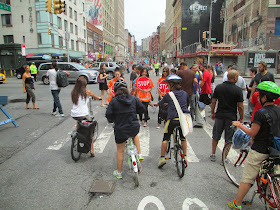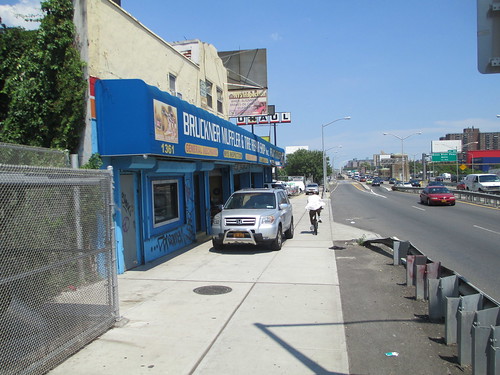On July 17, as I cycled to work, amid
the chaos of rush-hour downtown Brooklyn , I
spotted a narrow gap to the right of a line of stationary traffic. I moved into
it and rode cautiously towards the next intersection. Then, to my shock, I
realised a taxi driver had decided there was room between me and the other traffic
for him also to squeeze through. He drove past me, much faster than I was
going, leaving at most around six inches to spare. Knowing that any
miscalculation would have had me tumbling under the taxi’s wheels, I felt a
surge of panic and rage.
 |
| Close pass: here's how it looks when I try to photograph a taxi moments after it's come within inches of me with the lens on zoom and my hands still shaking |
Numerous current road safety
campaigns – including one by Transport for London , the London Mayor’s transport
organisation – would imply that what I did next made me just as bad as the
negligent driver. Catching up with him and still feeling the shock of his
pointless, dangerous behaviour, I yelled at him: “You could have killed me.
You’re a dangerous driver.” Looking at me with stone dead eyes, he languidly
rolled up the passenger-side window and drove off as fast as the traffic jam
would allow.
The Transport for London campaign
– which inevitably uses the shopworn “share the road” slogan – would have
enjoined me to ignore the driver’s actions, take a deep breath and head on my
way as if nothing had happened. “Leave it on the road,” it advises road users.
It isn’t, I think, advice about what one should do with the body fluids and
teeth of people that rile one.
My example highlights the insane
irrationality of such campaigns. A “leave it on the road” approach to road
safety suggests that the real problem is people’s malice towards each other or
negative perceptions. It ignores the evidence that negligence, inattention and
poor risk assessment are significant causes of car crashes. It puts the focus
on vulnerable road users’ reaction to negligent driving. It suggests that all
cyclists and pedestrians are somehow collectively responsible for each others’
behaviour. Motorists are helpless vessels full of potential rage that cyclists
or pedestrians can make explode or safely depressurise. The approach serves no
conceivable purpose other than to comfort people like the taxi driver who put
me at risk. “Yes,” is the hidden message. “The real problem is those nasty,
lippy cyclists.”
Such campaigns nevertheless enjoy such
continued credibility that I found myself arguing vigorously recently with a
cyclist who trenchantly defended a campaign by the state government of Utah under the title
“Respect is a Two-Way Street”. Most problems cyclists encountered on the road
were a result of motorists’ past experience of bad cyclist behaviour, my
interlocutor assured me.
 |
| I came upon this two-car shunt on Saturday on the Upper East Side, an eminently respectable neighbourhood. But was a lack of respect between drivers the real problem? |
Yet it’s
self-evidently bizarre to argue that the solution to drivers’ killing people is
to ask everyone to be nice. There is a quality-of-life argument for asking
people to be calmer and more tolerant. I try when I haven’t been put in fear of
my life to act considerately. But it’s hard to see that “share the road”
campaigns are a better route to that destination than making the roads safe.
The question is why “share the road” campaigns continue to consume energy that
could be better directed elsewhere.
I suspect the
answer is that transport authorities face a choice between conveying messages
that are broadly popular and bringing about changes that are likely severely to
annoy many. It’s not a surprise – though it’s certainly a disappointment – that
the former so consistently wins.
 |
| Cyclists respectfully wait when asked to stop at this year's Summer Streets event. What is it about this motor vehicle-free environment that suddenly makes cyclists show people more respect? |
It’s not hard,
after all, to guess such campaigns’ genesis. Many cities worldwide, in gestures
towards environmental concern, congestion relief or obesity prevention, have
sought to encourage cycling, many with more success than they expected. Surges
in cyclist numbers on roads designed to facilitate smooth car movements have
often led to spikes in cyclist deaths, even if the death rate per mile cycled
has usually fallen. “Share the road,” “mutual respect” and other similar
campaigns are all manifestations of public officials’ dilemma. They don’t want
to stop the growth of cycling but lack the political capital or courage to
upset vocal motorist groups, local shopkeepers, the local newspaper or the many
other noisy defenders of the status quo. It must seem a beguilingly simple
solution to tell everyone to up their game and hope the problem goes away.
The laws of
physics, human nature and psychology keep getting in the way, however.
The taxi driver
who brushed by me was driving a Toyota Highlander – a vehicle that weighs 2.5
tonnes – and moving considerably faster than I. That would have made a critical
difference if he had actually hit me. His vehicle’s momentum, mass and size
surely meant he had a far greater duty to be careful than I had. The emotional
stakes were also entirely different. I seek to keep myself safe precisely
because I know the odds if I’m hit. The driver could afford to keep his sang froid precisely because, as the
driver of a large SUV, he was effectively invulnerable. I was acutely aware of
how close he’d come to me because I was out in the open and constantly watching
for danger. Sitting on the far side of a 6’ 4” (nearly 2m) wide vehicle, the
driver probably had little conception of quite how much he was endangering me.
 |
| A car parked on a Bronx sidewalk-cum-cycleway. If only that cyclist had shown more respect, perhaps the driver wouldn't have felt forced to act this way. |
New York City has
not actually run a “mutual respect” campaign in the time I’ve been here but
I’ve heard all the most senior road safety figures in the city – the transport
commissioner, head of the police’s traffic squad and the head of the state
department of motor vehicles – back the approach in speeches. The police
commissioner erroneously claimed earlier this year that fatally-struck pedestrians
tended to cause their own deaths – an entirely untrue assertion that, if it
were true, would make some sense of “share the road” campaigns. The tenor of
many of the police’s actions – the determination to hand out traffic tickets to
pedestrians and, disproportionately, cyclists as well as motorists – seems to
reflect the same thinking.
This
“even-handed” approach isn’t making people safer, however. According to figures from WNYC,
the radio station, 141 people had died in traffic in the city up to August 1,
which makes it seem likely there will be almost as many traffic fatalities this
year as the 274 in 2013. I can’t find any statistics for road deaths so far in
London this year but there’s little indication its record – while far better,
per capita, than New York’s – is improving much.
 |
| Parked cars block the new two-way bike lane on Kent Avenue, South Williamsburg: it's absolutely clear how much extra mutual respect would help alleviate this problem. |
There isn’t any
great mystery which approach would make the big cities of the English-speaking
world genuinely safer. London has a better record than New York partly because London
But such measures
seem to give rise in many people to a kind of existential panic. Powerful
groups – men, privileged races, imperial powers – tend to think that they have
their jobs, their access to better schools, their political power or their
access to road space by right and by merit rather than as a result of rigged
power structures. The howls of protest have the same tone of injured innocence
I’ve heard in the past from Northern Irish Protestants, Kosovo Serbs and others
who see privileges taken for granted being eroded.
I don’t pretend
that it’s an easy political choice to take on those vested interests. There
would be bitter, angry complaints if New
York City